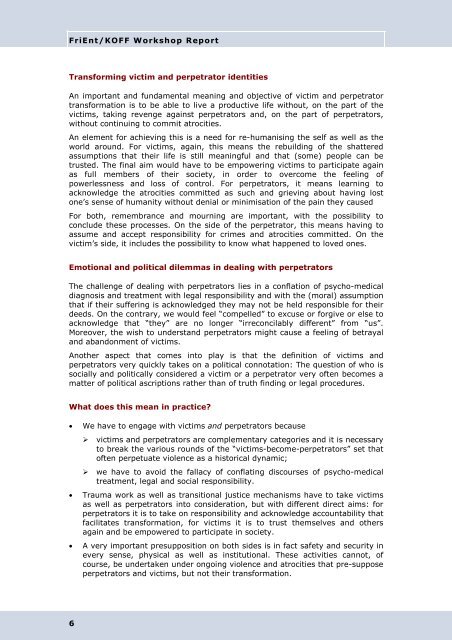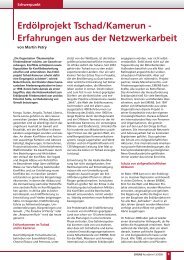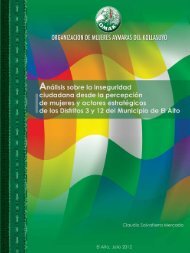Engaging with Victims and Perpetrators in Transitional ... - FriEnt
Engaging with Victims and Perpetrators in Transitional ... - FriEnt
Engaging with Victims and Perpetrators in Transitional ... - FriEnt
- No tags were found...
Create successful ePaper yourself
Turn your PDF publications into a flip-book with our unique Google optimized e-Paper software.
<strong>FriEnt</strong>/KOFF Workshop ReportTransform<strong>in</strong>g victim <strong>and</strong> perpetrator identitiesAn important <strong>and</strong> fundamental mean<strong>in</strong>g <strong>and</strong> objective of victim <strong>and</strong> perpetratortransformation is to be able to live a productive life <strong>with</strong>out, on the part of thevictims, tak<strong>in</strong>g revenge aga<strong>in</strong>st perpetrators <strong>and</strong>, on the part of perpetrators,<strong>with</strong>out cont<strong>in</strong>u<strong>in</strong>g to commit atrocities.An element for achiev<strong>in</strong>g this is a need for re-humanis<strong>in</strong>g the self as well as theworld around. For victims, aga<strong>in</strong>, this means the rebuild<strong>in</strong>g of the shatteredassumptions that their life is still mean<strong>in</strong>gful <strong>and</strong> that (some) people can betrusted. The f<strong>in</strong>al aim would have to be empower<strong>in</strong>g victims to participate aga<strong>in</strong>as full members of their society, <strong>in</strong> order to overcome the feel<strong>in</strong>g ofpowerlessness <strong>and</strong> loss of control. For perpetrators, it means learn<strong>in</strong>g toacknowledge the atrocities committed as such <strong>and</strong> griev<strong>in</strong>g about hav<strong>in</strong>g lostone’s sense of humanity <strong>with</strong>out denial or m<strong>in</strong>imisation of the pa<strong>in</strong> they causedFor both, remembrance <strong>and</strong> mourn<strong>in</strong>g are important, <strong>with</strong> the possibility toconclude these processes. On the side of the perpetrator, this means hav<strong>in</strong>g toassume <strong>and</strong> accept responsibility for crimes <strong>and</strong> atrocities committed. On thevictim’s side, it <strong>in</strong>cludes the possibility to know what happened to loved ones.Emotional <strong>and</strong> political dilemmas <strong>in</strong> deal<strong>in</strong>g <strong>with</strong> perpetratorsThe challenge of deal<strong>in</strong>g <strong>with</strong> perpetrators lies <strong>in</strong> a conflation of psycho-medicaldiagnosis <strong>and</strong> treatment <strong>with</strong> legal responsibility <strong>and</strong> <strong>with</strong> the (moral) assumptionthat if their suffer<strong>in</strong>g is acknowledged they may not be held responsible for theirdeeds. On the contrary, we would feel “compelled” to excuse or forgive or else toacknowledge that “they” are no longer “irreconcilably different” from “us”.Moreover, the wish to underst<strong>and</strong> perpetrators might cause a feel<strong>in</strong>g of betrayal<strong>and</strong> ab<strong>and</strong>onment of victims.Another aspect that comes <strong>in</strong>to play is that the def<strong>in</strong>ition of victims <strong>and</strong>perpetrators very quickly takes on a political connotation: The question of who issocially <strong>and</strong> politically considered a victim or a perpetrator very often becomes amatter of political ascriptions rather than of truth f<strong>in</strong>d<strong>in</strong>g or legal procedures.What does this mean <strong>in</strong> practice?• We have to engage <strong>with</strong> victims <strong>and</strong> perpetrators because victims <strong>and</strong> perpetrators are complementary categories <strong>and</strong> it is necessaryto break the various rounds of the “victims-become-perpetrators” set thatoften perpetuate violence as a historical dynamic; we have to avoid the fallacy of conflat<strong>in</strong>g discourses of psycho-medicaltreatment, legal <strong>and</strong> social responsibility.• Trauma work as well as transitional justice mechanisms have to take victimsas well as perpetrators <strong>in</strong>to consideration, but <strong>with</strong> different direct aims: forperpetrators it is to take on responsibility <strong>and</strong> acknowledge accountability thatfacilitates transformation, for victims it is to trust themselves <strong>and</strong> othersaga<strong>in</strong> <strong>and</strong> be empowered to participate <strong>in</strong> society.• A very important presupposition on both sides is <strong>in</strong> fact safety <strong>and</strong> security <strong>in</strong>every sense, physical as well as <strong>in</strong>stitutional. These activities cannot, ofcourse, be undertaken under ongo<strong>in</strong>g violence <strong>and</strong> atrocities that pre-supposeperpetrators <strong>and</strong> victims, but not their transformation.6
















